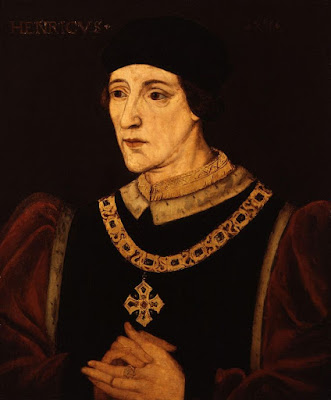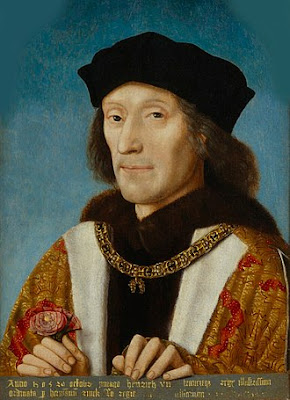Poor Henry VI. He was not cut out for his job. As you will recall from Part 3, he became King of England in 1422 as an infant, the third Lancastrian king and the youngest person ever to inherit the Crown. [Image: Henry VI]
He was also proclaimed King of France and crowned in 1431, but never ruled that country. One could argue he never really ruled England either. Henry VI had the dubious distinction of being King of England twice, sandwiched around Edward IV, who also held the job twice. It is not even certain he knew he was king.
While Henry was growing up in age, a regency council ruled in his name. In 1437, he assumed control of the government. He had become older. He had not grown up. He may have made a good monk, but not a good monarch for a country overrun by noble thugs.
During the wars with France, the great lords had become recruiters for the army. They hired "retainers" to fight for pay. The retainers became private armies of the powerful nobles. Historians labeled the system "bastard feudalism."
By 1453, the Hundred Years War ended in English defeat. War abroad soon gave way to war at home, as two families descended from Edward III competed for the throne, the House of Lancaster and the House of York. The struggle would last more than thirty years.
Historians labeled the conflict The Wars of the Roses. We can thank Shakespeare for that. In Henry VI, Part I, Shakespeare created a fictional scene in which supporters of the rival factions pick either red or white roses as their symbol: the red rose of Lancaster, and the white rose of York.
[Image: Plucking the Red and White Roses in the Old Temple Gardens, print of fresco in the Palace of Westminster, by Henry Payne, 1910]
Nobody at the time thought they were fighting about roses. The white rose was indeed the symbol of the House of York. The red rose only became associated with the House of Lancaster after the wars.
"Wars" is also something of a misnomer. Actual fighting was sporadic and punctuated by years of uneasy peace. Most of the battles were small scale affairs, though bloody. They were fought mainly by private armies of retainers in the pay of wealthy nobles, a bit like Mafia gangs.
Teaching the Wars of the Roses was always a struggle for me. To try and explain the complex relationships among the participants and the coming and going of kings is daunting. Everyone seems to be named Henry, Edward, or Richard. They are all descended from Edward III, who had too many children.
You may recall that in 1399 Henry IV had deposed his cousin Richard II and claimed the throne. His claim was never fully accepted by some nobles. They thought Edmund Mortimer, 5th Earl of March, was the rightful heir.
Henry IV crushed uprisings in Mortimer's favor. Mortimer, a child at the time, never pursued his claim himself, and Henry treated him well. In fact, Mortimer became a trusted counsellor to the Lancastrian kings before his death in 1425.
Things changed when the French war ended in defeat and domestic chaos. In the 1450s Richard Duke of York revived the Mortimer claim. Mortimer had no children, but York was his nephew and heir.
Richard was emboldened by Henry VI's lack of kingly skills. In contrast to his father Henry V, he was not a bold warrior. He was timid, shy, and pious. He disliked war and violence. He was also prone to periodic mental breakdown.
By the early 1450s, England was descending into anarchy. Bands of armed retainers, returned from plundering France, began to terrorize England. Richard of York presented himself as the man who could restore order. He sought to gain control over the government, which meant Henry VI. Henry's French queen, Margaret of Anjou, who wore the trousers, opposed Richard's plan. In 1455, civil war broke out.
A victorious Richard captured Henry. He got Parliament to name him Lord Protector and Henry's successor. Margaret refused to accept the deal, which disinherited her son. She raised a Lancastrian army, which defeated and killed Richard in battle.
The victory did not eliminate the Yorkist threat. Richard's eldest son Edward took up his claim. In 1461 he won a decisive victory over Lancastrian forces at the Battle of Towton. It was a truly big battle. More than 50,000 soldiers were engaged, and it was fought in a blinding snowstorm. Henry VI fled the field and the country. [Image; Edward IV]
Edward seized the vacant throne. As Edward IV, he ruled mostly in peace for nine years. But in 1469 his most powerful ally, Richard Neville, Earl of Warwick, turned against Edward. Warwick had provided key support to Edward and before that, to Edward's father.
"The Kingmaker," as Warwick became known, allied with Margaret of Anjou, wife of Henry VI. They assembled an army in France and invaded England in 1471. Edward, caught by surprise, fled to France. Warwick made the feeble Henry VI king once again. But not for long.
Edward raised an army in France and returned. Two Yorkist victories left Warwick and Henry VI's only son dead. Edward imprisoned Henry, who died soon after, possibly murdered.
In 1478, Edward accused his brother George, Duke of Clarence, of treason, with good reason. He banished Clarence to the Tower of London, where he was privately executed. A rumor spread that he was drowned at his own choice in a butt of malmsey wine, a rich and sweet madeira. True or not, at least it helped me learn what malmsey is.
Edward ruled England for another twelve years in relative peace, which the country sorely needed. When he died in 1483, it seemed that the wars were finally over, and a peaceful succession would follow.
His thirteen-year-old son was named king as Edward V. At first, the transference of power seemed likely to go smoothly. That changed when Edward's other brother, Richard, Duke of Gloucester, raised an objection.
Richard had been staunchly loyal to his older brother, and Edward named him as Lord Protector of his children in the event of his death. Richard swiftly seized control of the young king and his younger brother from their mother's family. He had them both placed in the Tower of London.
Richard followed with astonishing news. He claimed that the sons of Edward IV were bastards; that his brother's marriage to their mother, Elizabeth Woodville, was invalid. I'll skip the technicalities. Parliament, perhaps overawed by Richard's power, declared the young princes illegitimate and Richard rightful king. [Image: Richard III, earliest surviving portrait, 1520]
In the months following Richard III's seizure of power, the princes were seen less and less, and finally not at all. Did Richard have them murdered? Or did someone else arrange the deed to smear Richard?
Some defenders of Richard argue that one of Richard's allies, the Duke of Buckingham, turned against him and arranged the murders to blacken his character. Others claim that the man who replaced Richard as king, Henry Tudor, was the true culprit.
The evidence is inconclusive. In some people's eyes Richard III is the wickedest king in English history. To others, he is an innocent victim framed by Tudor historians, who influenced Shakespeare's portrayal of Richard in Richard III. The contrast in views could hardly be greater.
Shakespeare's Richard is a monster, a hunchback who thrives on killing those blocking his path to power. The playwright even accuses two-year-old Richard of murder, and of ruthlessly killing someone at a battle at which he wasn't even present.
Shakespeare can't be entirely faulted. He was relying on chroniclers favorable to the Tudors. They created the monster, as part of a propaganda campaign designed to strengthen the claim of the Tudors to the throne. "Look what we saved you from" was the message.
Richard's defenders have rejected the Tudor portrait, and in doing so, have unduly whitewashed him. He could be as ruthless as his enemies and rivals. Whether or not he had the princes killed, he certainly was responsible for eliminating members of the Woodville family and some of their supporters. Mafioso would understand.
In 1485, Henry Tudor, half Welsh and a supporter of the Lancastrians, raised an army and challenged Richard. They met on Bosworth Field, near Leicester. One of Richard's allies changed sides in the middle of the battle, throwing victory to Henry.
According to Shakespeare, Richard was killed after being unhorsed, crying, "A horse, a horse, my kingdom for a horse!" Well, by now you should have learned to take Shakespeare's history with a grain of salt.
After the battle, Richard was hastily buried in a monastic church in nearby Leicester. For centuries, he remained there, while debate raged over whether or not Shakespeare was correct to describe him as a hunchbacked monster.
The church and its cloisters were demolished during Henry VIII's dissolution of the monasteries in the 1530s. In the 20th century, the former monastic site became a car park. ("Don't it always seem to go, that you don't know what you've got till it's gone." Not to say it was paradise.
In 2012, archeologists who had pinpointed the location of the demolished monastery, found the remains of a body in the car park. They announced that they believed it was that of Richard III.
The skeleton displayed numerous wounds. It also showed signs of scoliosis, a spinal deformity which may have given rise to stories that Richard was hunchbacked. Perhaps Shakespeare had been sort of right about that, after all. DNA analysis confirmed that the remains were Richard's.
The victor of Bosworth Field, Henry Tudor, wasted no time after the battle. He went straight to London and claimed the throne. He was descended from John of Gaunt, Duke of Lancaster, through his mother. Others had a better hereditary claim than Henry. But that didn't stop him. He would take care of that problem later.
[Image; Henry VII, first Tudor monarch]
To strengthen his position, Henry arranged a hasty marriage to Edward IV's eldest daughter, symbolically uniting the houses of Lancaster and York. He also had a new rose commissioned, the red and white Tudor Rose, a symbolic uniting. In the portrait above, he is holding the rose in his right hand.
Henry VII had to fight one more battle, in 1487, against the army of an imposter claiming to be Edward V. After eliminating that threat, Henry secured his dynasty. His children and grandchildren would rule England until 1603. To judge by the number of books and films about the Tudors, one might be pardoned for thinking they were the only monarchs in English history, before Elizabeth II or this new guy.
If you enjoyed this post and would like to become a follower of my blog, just click on the blue "FOLLOW" button on the right side of the first page. Below there you can also find my previous posts. Thanks!





Loved the Joni quote. I lived in Leicester in 1997, and visited a number of museums that told versions of Richard III's history. The discovery of his remains was of real interest because I walked across that car park to get to a bus stop. I'm excited when a new monarch's story appears. Just think what it would have been with social media.
ReplyDeleteLoved the Joni quote. I lived in Leicester in 1997 and visited all the museums that told various parts of Richard's story. When the remains were discovered, it was a car park I walked across to catch a bus. The House of Windsor is so tame in comparison.
ReplyDeleteThanks!
Delete